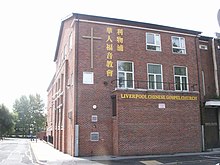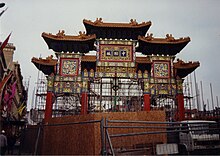Human settlement in England
| Liverpool Chinatown | |
|---|---|
 Chinatown Gate, Nelson Street Chinatown Gate, Nelson Street | |
| Metropolitan borough | |
| Metropolitan county | |
| Region | |
| Country | England |
| Sovereign state | United Kingdom |
| Post town | LIVERPOOL |
| Postcode district | L1 |
| Dialling code | 0151 |
| Police | Merseyside |
| Fire | Merseyside |
| Ambulance | North West |
| UK Parliament | |
| |
| Liverpool Chinatown | |||||||||||||
|---|---|---|---|---|---|---|---|---|---|---|---|---|---|
| Traditional Chinese | 利物浦中國城 | ||||||||||||
| Simplified Chinese | 利物浦中国城 | ||||||||||||
| |||||||||||||
| Alternative Chinese name | |||||||||||||
| Chinese | 利物浦唐人街 | ||||||||||||
| |||||||||||||
Chinatown is an area of Liverpool, England, that is home to the oldest Chinese community in Europe. Based in Great George ward in the south of the city centre, Chinatown has many Chinese businesses, restaurants and supermarkets, and facilities for the Chinese community. The area is also notable for its Chinese-style architecture; with the paifang on Nelson Street being the largest, multiple-span arch of its kind outside China.
History
Establishment
The first presence of Chinese people in Liverpool dates back to 1834 when the first vessel direct from China arrived in Liverpool's docks to trade such goods as silk and cotton wool. Many Chinese immigrants first arrived in Liverpool in the late 1860s as a result of Alfred Holt and Company employing large numbers of Chinese seamen while establishing the Blue Funnel Shipping Line. The commercial shipping line created strong trade links between the cities of Shanghai, Hong Kong and Liverpool; mainly importing silk, cotton and tea. From the 1890s onwards, small numbers of Chinese began to set up businesses catering to the Chinese sailors working on Holt's lines and others. Some of these men married working class British women, resulting in a number of British-born Eurasian Chinese being born in Liverpool.
World War II
At the beginning of World War II, there were up to 20,000 Chinese mariners in the city. In 1942, there was a strike for rights and pay equal to that of white mariners. The strike had lasted for four months. For the duration of the War these men were labelled as "troublemakers" by the shipowners and the British Government. At the end of the conflict, they were forbidden shore jobs, their pay was cut by two-thirds and they were offered only one-way voyages back to China. Hundreds of men were forced to leave their families, with many of their locally born children continuing to live in and around Liverpool's Chinatown to this day.
Liverpool's first Chinatown existed within the city's docklands, although heavy bombing during World War II led to a relocation to the current spot just west of Liverpool Cathedral.

Regeneration
The Chinese Arch was assembled in 2000 (after being built in one of Liverpool's twin cities – Shanghai) as a mark of redevelopment of the area, which is still continuing today.
Plans to redevelop a significant portion of Chinatown were revealed in October 2010 and April 2012 respectively. One scheme named 'China Square' is to include a Chinese Cultural Museum and Courtyard by Marriott in the former Scandinavian Hotel building. Another regeneration project tipped to take place is 'Shanghai Square', which when built will occupy the southern fringes of Chinatown. The proposal includes building a 23,000 m (250,000 sq ft) trade centre that will provide space for up to 100 businesses, specialist accommodation for Chinese students as well as a large Asian Pacific food market.
Geography
The Chinatown in Liverpool, England is located near the city centre's southern edge close to Liverpool Cathedral. The city's Chinatown district has spread significantly since its first establishment, now taking up much of Berry Street. The streets of Liverpool's Chinatown are decorated with Chinese-style lanterns, waste bins and all street signs are written in English and Chinese.
Street names

| English name | Chinese name | Romanisation | ||
|---|---|---|---|---|
| Simplified | Traditional | Mandarin (Pinyin) |
Cantonese (Jyutping) | |
| Bailey Street | 贝利街 | 貝利街 | Bèilì Jiē | bui lei gaai |
| Berry Street | 巴利街 | 巴利街 | Bālì Jiē | baa lei gaai |
| Cornwallis Street | 康和利士街 | 康和利士街 | Kānghélìshì Jiē | hong wo lei si gaai |
| Cummings Street | 卡明斯街 | 卡明斯街 | Kǎmíngsī Jiē | kaa ming si gaai |
| Duke Street | 公爵街 | 公爵街 | Gōngjué Jiē | gung zoek gaai |
| Griffiths Street | 居富士街 | 居富士街 | Jūfùshì Jiē | geoi fu si gaai |
| Knight Street | 励德街 | 勵德街 | Lìdé Jiē | lai dak gaai |
| Nelson Street | 纳尔逊街 | 納爾遜街 | Nà'ěrxùn Jiē | naap ji seon gaai |
| Roscoe Lane | 罗士高里 | 羅士高里 | Luóshìgāo Lǐ | lo si gou lei |
| Sankey Street | 桑基街 | 桑基街 | Sāngjī Jiē | song gei gaai |
| Seel Street | 兆街 | 兆街 | Zhào Jiē | siu gaai |
| Upper Duke Street | 上公爵街 | 上公爵街 | Shàng Gōngjué Jiē | soeng gung zoek gaai |
Demography
2007 estimates state 1.7% of Liverpool's population as being of full Chinese descent (some 7,400 people), making it the city's single largest non-White ethnic group. The International Organization for Migration, by contrast, has estimated that the number of Chinese people in Liverpool could range between 25,000 and 35,000. There is also a large number of Chinese Liverpudlians of mixed European and Chinese ethnicity, descendants of the earlier generations of Chinese settlers in the city.
Liverpool's universities also host a large number of Chinese students, with the University of Liverpool having the largest number of Chinese students of any university in the UK.
Economy
Chinese owned restaurants, supermarkets (including Chung Wah and Hondo), book shops and other businesses are now spread throughout the district. The large and increasing Chinese student population has seen the growth of a new network of businesses catering to the needs of Mainland Chinese students, building upon the existing Chinatown in the city.

Culture and community
Facilities
Chinatown is also home to many community organisations as well as the Liverpool Chinese Gospel Church and the Liverpool Chinese Christian Disciples Church.
Landmarks
Chinese arch

Planning for an arch began in 1992 as part of a regeneration scheme by Liverpool City Council for the Chinatown area. Designs for the arch were chosen by the local Chinese community through a competition.
Initial construction began in October 1999 as part of the Ropewalks Phase 1 regeneration, with Dowhigh Civil Engineering of Bootle, Liverpool being announced as principal contractor and the arrival of 20 specially selected craftmen from Liverpool's twin city of Shanghai. The craftsmen included stonemasons, stone carvers, painters and construction engineers. Along with the Chinese workers, block components manufactured by The Shanghai Linyi Garden Company Ltd were also shipped from China to Liverpool in five large containers with 2,000 pieces. Overall design was co-ordinated through the architectural practice of Wilkinson Hindle Hallsall and Lloyd with Liverpool City Council providing engineering design and supervision of the infrastructure and structural frame to the arch. Work finished in a relatively short time period of 90 days. This was due to the Chinese workers not traditionally celebrating Christmas and Boxing Day meaning that they could carry on working. Building of the arch finished in 2000 and was officially opened on Chinese New Year at a final cost of £700,000.
Standing at 13.5 metres (44 ft) high the arch is the tallest in Europe and the second tallest in any Chinatown outside mainland China. (Washington D.C. having the tallest outside China at 47 ft.) The arch boasts 200 hand carved dragons of which 188 are ordinary and 12 are pregnant, the meaning of which is to symbolise good fortune between Liverpool and Shanghai. The word "Chinatown" (trad. Chinese: 中國城; pinyin: zhōngguóchéng) is written on the centre of the arch from right-to-left using traditional Chinese characters. In 2010 as part of a £25,000 lighting scheme, multicoloured, low energy illuminating lights were added to the arch as a way to highlight one of Liverpool's significant structures.
See also
References
- "Liverpool Chinatown Museum". Dimsum. Archived from the original on 19 November 2008. Retrieved 21 November 2008.
- "Chinese Arch". Visit Liverpool. Retrieved 21 November 2008.
- "History of Liverpool Chinatown". The Liverpool Chinatown Business Association. Archived from the original on 24 January 2010. Retrieved 31 January 2011.
- ^ "Liverpool Chinatown History". Liverpool Chinatown. Archived from the original on 9 August 2020. Retrieved 29 October 2015.
- "Liverpool and its Chinese Seamen". halfandhalf.org.uk. Archived from the original on 2 October 2011. Retrieved 31 January 2011.
- "Let's aim high for Liverpool's Chinatown". Liverpool Echo. Retrieved 10 January 2010.
- "Plans revived for new hotel to replace city's derelict Scandinavian Hotel". Liverpool Echo. Retrieved 10 January 2010.
- ^ "Shanghai Square Ltd release plans for site at heart of Liverpool Chinatown land war". Liverpool Daily Post. Retrieved 8 August 2012.
- "Neighbourhood Statistics". Office of National Statistic. Archived from the original on 3 March 2016. Retrieved 31 January 2011.
- "China Mapping Exercise" (PDF). International Organization for Migration. Archived from the original (PDF) on 4 March 2012. Retrieved 20 April 2008.
- "10 UK universities that attract the most Chinese students". China Daily. Retrieved 18 December 2015.
- ^ "The 10th Anniversary of Liverpool Chinese Arch". Liverpool Chinese Business Association. 10 March 2010. Archived from the original on 23 July 2011. Retrieved 16 February 2011.
- Herbert, Ian (3 March 2000). "Liverpool pips its arch rival with gateway to Chinatown". The Independent. Archived from the original on 10 November 2012. Retrieved 18 February 2011.
- "Chinese Arch". Dowhigh Ltd. Archived from the original on 29 May 2019. Retrieved 16 February 2011.
- "Liverpool's Chinese arch ten years standing". BBC. 19 February 2010. Retrieved 18 February 2011.
- "Friendship Archway, (sculpture)". Smithsonian Institution Research Information System. Retrieved 18 February 2011.
- "Chinatown welcomes illuminated arch". placenorthwest.co.uk. 10 November 2010. Retrieved 18 February 2011.
External links
- Liverpool Chinatown website Archived 30 October 2020 at the Wayback Machine
| British Chinese topics | |||||
|---|---|---|---|---|---|
| Related groups | |||||
| Chinatowns | |||||
| Culture |
| ||||
| History |
| ||||
| Organisations | Liverpool Chinese Seamen's Union | ||||
| Lists | |||||
| Chinatowns in Europe | |
|---|---|
| Locations of Liverpool City Centre | |
|---|---|
53°23′57″N 02°58′38″W / 53.39917°N 2.97722°W / 53.39917; -2.97722
Categories:


